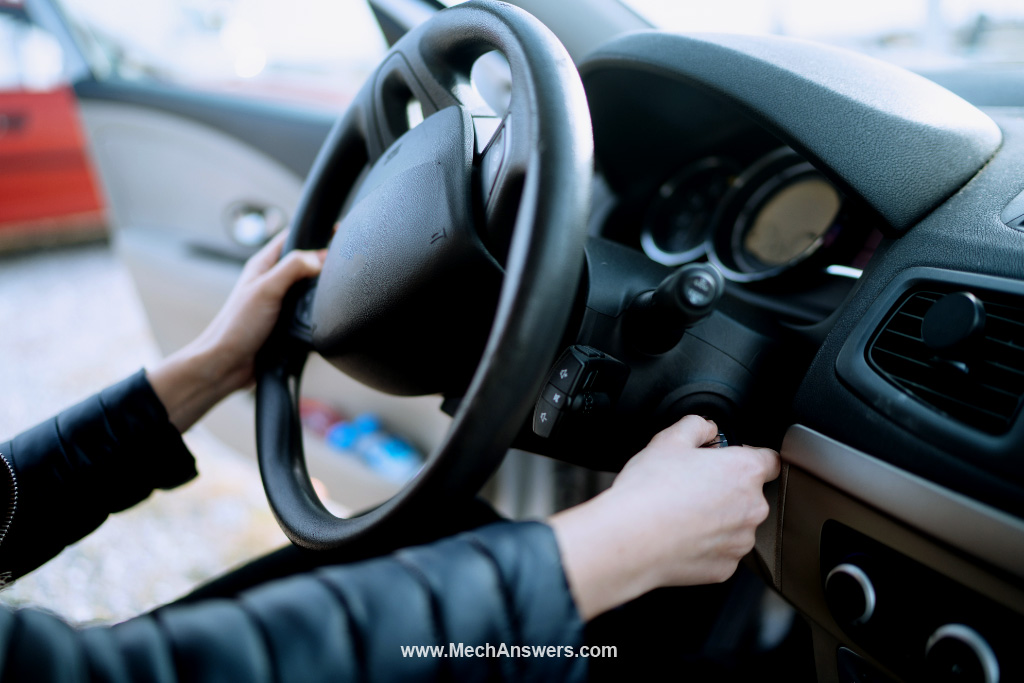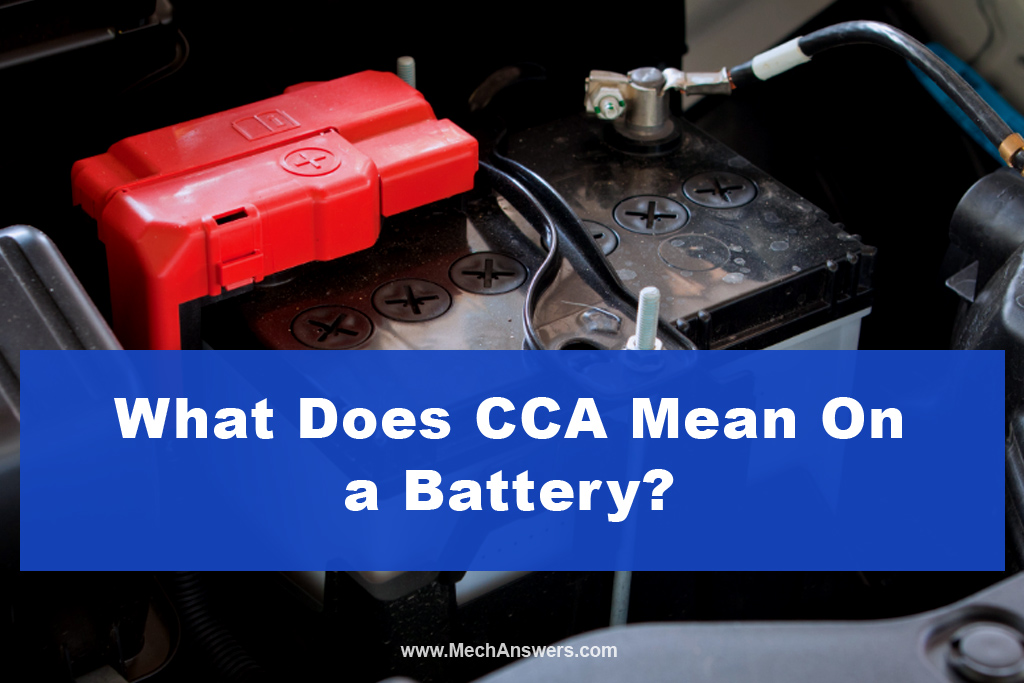You may have found yourself puzzled, possibly even searching the internet for “What Does CCA Mean On a Battery?”, haven’t you? Well, your search ends here.
So, what does “CCA” mean on a battery? CCA, short for Cold Cranking Amps, refers to the number of amps a 12-volt battery can deliver at 0°F for 30 seconds while maintaining a voltage of at least 7.2 volts. Essentially, it’s a critical measurement of the ability of a battery to start a car in cold weather conditions.
Reading this article will provide you with an in-depth understanding of how CCA affects battery performance, helping you make an informed decision when it’s time to buy a new car battery. Your vehicle’s reliability, especially in cold weather, could depend on it.

Table of Contents
History Of “Cranking Amps”
To understand how car batteries are rated, we’ll first take a dive into where the terminology comes from. Before cars had electric starting systems, the engine was started with a hand crank.
The driver would have to use their brute strength (which this system took a lot of!) to crank the engine on. The amount of power needed to start the car’s engine was called “cranking amps.”
It wasn’t until 1912 that the electric engine starter was included in cars. At the time, there wasn’t much information considering different factors affecting amperage.
Car manufacturers soon found that lower temperatures increased the viscosity of the liquids inside the engine, making it harder for the engine to start.
Batteries were also affected by the cold, too. The current it could provide is lower in colder temperatures, providing less energy.
Manufacturers created a new way of measuring the currents affected by temperature: Cold Cranking Amp. They used this new system to measure the current delivered in temperatures near or below freezing temperatures.
CCAs are lower than standard Cranking Amps. Both of these are measured as the amount of electrical current the battery can discharge and sustain for 30 seconds.
Here are the numbers that show the diminishing power as temperature drops:
| Power | Temperature | Power Required |
| 100% | 80 degrees Fahrenheit (F) | Normal |
| 65% | 32 degrees F | 150% more |
| 40% | 0 degrees F | 210% more |
| 25% | -20 degrees F | 350% more |
Because the cold weather makes batteries work harder to start your engine, global standards were created. Manufacturers and consumers would then know what type of batteries they would need in order to effectively work in their climate.
What Does CCA Mean On A Battery?
CCA stands for “cold cranking amps,” and it is a measure of a car battery’s ability to start an engine in cold weather. It is the amount of current a battery can deliver at 0°F (-18°C) for 30 seconds and not drop below 7.2 volts. The higher the CCA number, the greater the battery’s starting power.
MCA, CCA, and HCA – What’s the Difference?
MCA, CCA, and HCA are three important ratings for car batteries. Each rating provides information about how well the battery can perform in different environmental conditions. Understanding the differences between these ratings can help you choose the right battery for your vehicle.
MCA (Marine Cranking Amps)
MCA is a rating that measures the amount of current a battery can provide at 32°F (0°C). This rating is important if you live in an area with cold winters, as a battery’s performance is significantly affected by temperature. A battery with a high MCA rating can provide the necessary power even in extreme cold.
CCA (Cold Cranking Amps)
CCA measures the amount of current a battery can provide at 0°F (-17°C). This rating is important for vehicles that do a lot of work in very cold temperatures, such as snowplows and off-road vehicles. A battery with a high CCA rating can provide a long-lasting, reliable power source in these conditions.
HCA (Hot Cranking Amps)
HCA measures the amount of current a battery can provide at 80°F (26°C). This rating is important for vehicles that operate in hot climates, such as desert environments. A battery with a high HCA rating can provide a reliable power source in hot weather, ensuring your vehicle starts up each time.
MCA, CCA, and HCA are important ratings for car batteries. Each rating measures the amount of current a battery can provide in different environmental conditions, and understanding these differences can help you choose the right battery for your vehicle.
Understanding CCA Ratings
CCA ratings are most often found on lead-acid automotive batteries, and they are typically printed on the battery casing. This rating is an indication of the battery’s ability to start the vehicle in cold temperatures. The CCA rating is usually in the range of 300 to 900.
The CCA rating is determined by a battery manufacturer and is based on the battery’s capacity and design. The higher the CCA rating, the better the battery’s performance in cold temperatures.
Importance of CCA Ratings
It is important to choose a battery with the right CCA rating for your vehicle. If the CCA rating of the battery is too low, it will not be able to start the vehicle in cold weather. On the other hand, if the CCA rating is too high, you may be paying more money than necessary.
It is also important to note that the CCA rating of a battery is only valid at 0°F (-18°C). At higher temperatures, the CCA rating may be lower, which means the battery will not have as much starting power.
How Are CCA Ratings Found For Different Types Of Vehicles?
The first thing you should do when choosing the CCA number for your vehicle is to find the size of your vehicle. This can be found easily in your owner’s manual or with a simple internet search.
The standard suggestion is your battery should have at least one CCA per cubic inch of engine displacement on regular gasoline and two CCAs for diesel engines.
Let’s quickly break down engine displacement, too. This is the measurement is the combined displaced volume of air created by the piston movement in your engine’s cylinders.
The piston’s area, how far they move in the cylinder, and how many cylinders in the engine are all used to calculate how much air your engine displaces.
Don’t worry, though, you won’t have to take out your notepad and calculator! Vehicle manufacturers have the CCA requirements for every engine they produce. You can check your owner’s manual or the manufacturer’s website for this information.
Is There A Standard CCA Rating For My Vehicle’s Battery?
Generally speaking, there are CCA ranges for cars depending on their size. For example, smaller cars can have batteries as low as 150 CCAs, while pickup trucks and SUVs need higher amperages, around 400 to 500 CCAs. You can go even higher, up to 1150 CCAs, though this is very rarely necessary.
The biggest factor you should consider is the climate. Do you live in an area where you spend most of the winter in sub-zero temperatures?
Buying a battery with a higher CCA rate in this case would be smarter. But if you live in an area where the temperatures barely get below freezing, you can rely on the minimum CCA requirements set by your manufacturer.
It is safe to install batteries with a higher CCA rating in your car. Engines are designed to pull as much power as they need, so the engine and battery are safe no matter the CCA rate.
This means that you can install a battery with a higher CCA rating than necessary with little worry about any negative effects on your vehicle.
However, the higher CCA batteries do tend to leak more often, and they fail in hotter areas, too. Also, the higher CCA-rated batteries are larger, so you’ll want to check that the battery you want will fit in your vehicle’s battery tray.
What Is CCA On A Car Battery? >> Check out the video below:
Is It Good To Install A Higher CCA Battery In My Car?
Yes and No:
Yes:
If you are looking to replace your current battery with one that offers a higher Cold Cranking Amps (CCA) rating, then it is likely okay to do so.
No:
On the other hand, if the CCA rating of the replacement battery is higher than the original equipment manufacturer’s (OEM) battery specifications, then it is not recommended to use that battery in your car.
Checking OEM Specifications:
The best way to determine if it is okay to put a higher CCA battery in your car is to check the OEM specifications for the vehicle. This information can usually be found in the owner’s manual or on the vehicle’s manufacturer’s website.
How To Choose A Battery For My Vehicle
Consider the Cold Cranking Amps (CCA)
When choosing a car battery, one of the first things you should consider is the Cold Cranking Amps (CCA). The CCA is a measure of a battery’s ability to start your car in cold weather conditions.
It refers to the number of amps a 12-volt battery can deliver at 0°F for 30 seconds while maintaining a voltage of at least 7.2 volts. If you live in a cold climate, a battery with a higher CCA rating might be a necessary choice.
Check the Reserve Capacity
The Reserve Capacity (RC) of a battery is another important factor to consider. This is a measure of the battery’s ‘staying power’.
It represents the amount of time the battery can continuously supply minimum voltage levels without a charging system. This can be especially important in situations where your car’s alternator fails and you’re relying solely on the battery to keep your car running.
Choose the Right Size
Car batteries come in many different sizes, so it’s essential to pick one that fits your vehicle. Incorrectly sized batteries may not fit securely in your car’s battery tray, potentially leading to damage or short-circuiting.
Refer to your car’s owner’s manual or consult with an automotive parts store to find the correct size for your specific vehicle model.
Consider the Battery’s Age
When choosing a battery, make sure to check its age. The fresher a battery is, the better its performance is likely to be. Look for the manufacturing date on the battery’s case. Avoid batteries that are over six months old from the date of manufacture.
Opt for a Maintenance-Free Battery
Maintenance-free batteries, also known as sealed batteries, are designed to be unsealed and require no maintenance. This makes them a convenient option as you won’t have to worry about checking electrolyte levels or adding distilled water.
Ensure It Has A Good Warranty
Lastly, when buying a new car battery, it’s important to ensure it comes with a good warranty. A battery warranty can give you peace of mind and save you money in case the battery fails or performs poorly. Compare warranties of different batteries and choose one that offers the best protection.
By taking these factors into consideration when choosing a battery, you’ll be able to select a battery that not only fits your vehicle but also meets your specific driving and climatic conditions. This will ensure your car is always ready to start, even in the coldest weather.
Read more – What Can A Bad Car Battery Cause? (Signs & Symptoms)
Read more – Can a Bad Battery Throw Codes? (Simply Explained)
Final Thoughts
Many people who live in warmer climates may not have even heard of the CCA rating of their battery. But for those who live in more frigid conditions, the CCA rating is an important factor to consider before purchasing batteries for their vehicle.

